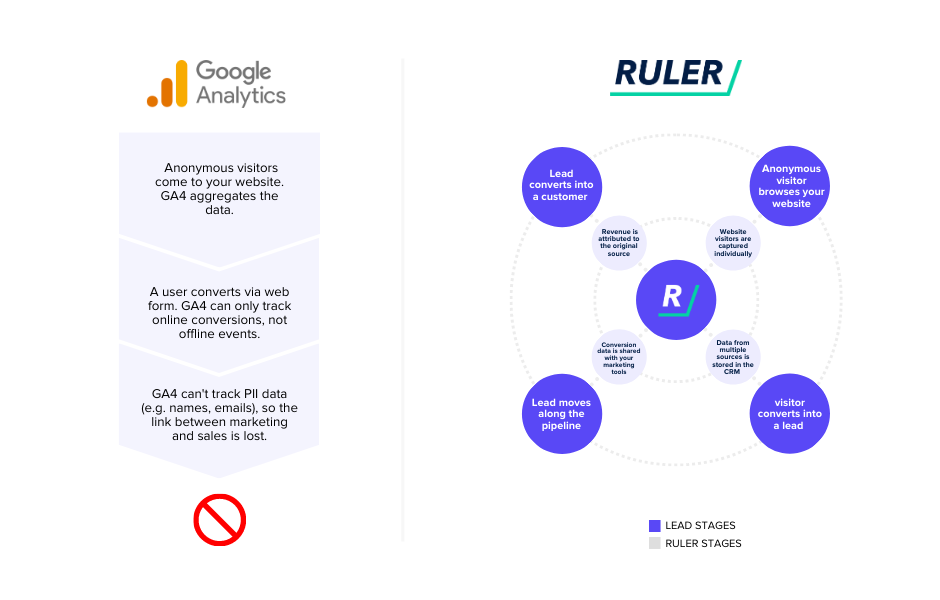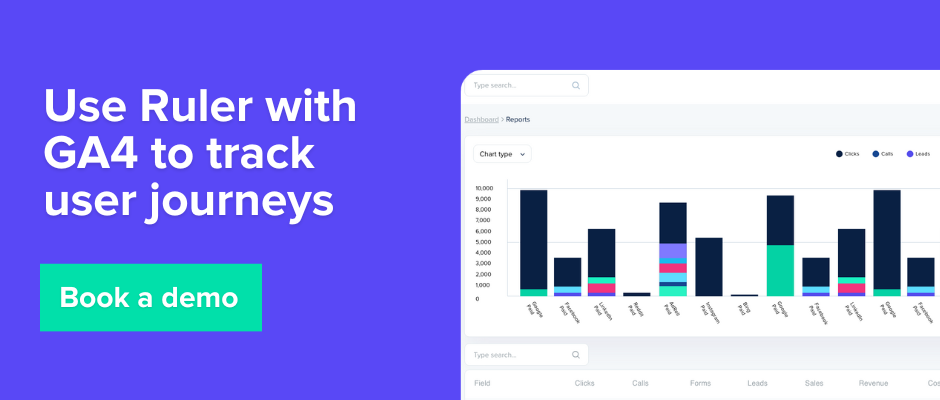We explore the limitations of GA4 and show you the best ways to overcome them.
Google Analytics has been a vital tool for marketers for many years – our data shows that 90% of marketers use Google Analytics as their primary analytics tool.
However, the sunsetting of UA and changeover to GA4 has thrown this up in the air. Marketers seem torn on whether it’s a positive or negative change and don’t yet fully understand what’s truly missing from GA4 that might impact them.
Google Analytics 4 is a fantastic tool for measuring your website performance, but when it comes to deeper measurement, it doesn’t provide the depth of insights required to truly measure the effectiveness of marketing activities.
Some of its limitations include:

Ruler is a powerful tool that complements Google Analytics. While GA4 provides valuable insights into website traffic, Ruler can provide more granular data on individual visitors. This allows you to better understand how visitors interact with your website and attribute leads and revenue back to specific marketing sources.
Book a demo to see how Ruler works with GA4
Data sampling adds a lot of guesswork to your data. GA4 is increasing its reliance on sampled data and machine learning to fill data gaps.
This move has been done to try and compensate for data changes since the removal of third-party cookies.
But what you’re left with is a lack of knowledge about how accurate your data really is.
The shift from your real data does depend on your data size and data quality, but it isn’t clear exactly how this impacts your reports.
To overcome this challenge, you can link GA4 with BigQuery. If you’re unfamiliar with BigQuery, it’s a Google Cloud Platform service that allows you to store and analyse large amounts of data without sampling.
Once you have linked GA4 with BigQuery, you can use it to:
When you view reports in Google Analytics, you’re seeing overall visitor data. For example, the number of visitors to your website, the pages they visit, and the time they spend on your website.
Google Analytics can’t track any personally identifiable information on website users. You can’t break down your web traffic by visitor level and track data such as names, email addresses, or phone numbers.
Without PII data in Google Analytics 4, it’s hard to identify and track the marketing sources that are pushing quality leads and deals into your pipeline. As a result, the link between marketing and revenue is effectively broken.
Google Analytics does not track personally identifiable information (PII) data, but there are workarounds. One such workaround is to use a marketing attribution tool. Marketing attribution tools can track your customer journeys and help you understand how different marketing sources contribute to revenue.
Take Ruler, for example.
Ruler allows you to track the path a customer takes from the first time they interact with your brand to the point where they make a purchase.

It uses a pre-built integration to send revenue from your deals back to the marketing touchpoints that resulted in the conversion, allowing you to:

Ruler can shed more light on your customer journeys and help prove the ROI of your marketing efforts. Don’t just take our word for it. See how Ruler has helped Totalmobile increase ROAS by 23%, or book a demo to see it in action.
Book a demo and generate better insights
Google Analytics 4 has made some big changes to its attribution models. Previously, GA4 offered a variety of attribution models, including first-click, linear, time decay, and position-based.
However, Google has decided to sunset all of these models except for last-click and data-driven attribution.
Google says that the decision to sunset these models was made to keep up with the changing digital landscape. The company claims that rule-based attribution models are no longer accurate or flexible enough to track the complex buying journeys of today’s consumers.
The update has led to mixed reactions from marketers. Some are concerned about the loss of data and tracking visibility that will result from the sunsetting of the rule-based attribution models.
Only time will tell how the changes to GA4’s attribution models will impact marketers.
However, it is clear that Google is committed to providing its users with the most accurate and up-to-date attribution data possible.
Marketers who are concerned about the loss of data and tracking visibility that will result from the sunsetting of the rule-based attribution models may want to consider using a third-party attribution platform.
Marketing attribution can provide more accurate and flexible attribution data than GA4’s built-in models.
We’ve already discussed Ruler, but it’s important to note that it offers a wide range of attribution models, including all of those previously available in Google Analytics.
This means you can have more control over how you measure your marketing performance and attribute credit for leads and deals.
The free version of Google Analytics 4 has data collection limits for event parameters and user properties that you need to be aware of:
The paid version of Google Analytics 360 removes these limitations and offers:
GA 360 does come at a price. If you can’t afford GA4, then you can also consider the following options:
As of March 2023, Google Analytics 4 has been banned in the following countries:
These countries have banned GA4 because they believe that the way that GA4 collects and transfers data violates their data protection laws.
One standout violation is that GA4 transfers data to the United States. The US isn’t considered an adequate data protection country under the laws of these EU countries.
There’s a risk that the data could be accessed by government agencies without the user’s consent.
Until Google makes the required updates to be sufficiently GDPR compliant, there’s not much you can do.
Google has said that it is working to address the concerns of the data protection authorities in the EU. However, it is not clear when GA4 will be fully GDPR compliant.
In the meantime, there are several website analytics tools that you can use in these countries.
These tools are 100% GDPR-compliant and offer a variety of features that can help companies track their website traffic and marketing campaigns.
We put a few of them in a list of Google Analytics alternatives, which you can find here.
Google does not offer dedicated support or onboarding for Google Analytics 4.
This means that businesses, especially large businesses with complex setups, are left to figure out how to set up and customise GA4 on their own.
This can be a daunting task, especially for businesses that are not familiar with GA4.
There are a few things you can do to solve the problem of no dedicated support from Google Analytics:
It will take some time, but by following these tips, you can get a better grip on GA4 and start using it to improve your website and marketing campaigns.
Google Analytics 4 is a popular web analytics platform, but it has some inherent limitations around reporting and privacy.
First, Google Analytics only tracks traffic at the aggregate level. It can’t tell you who specific users are, what channels they used to convert or how far they made it down the funnel.
Second, it’s banned in some countries due to privacy concerns. This means that marketers in these countries can’t use Google Analytics 4 to track their website traffic or user behaviour.
These limitations are prompting more users to consider alternatives, like Ruler Analytics.
Ruler’s marketing attribution tracks individual users, allowing you to close the gap between your marketing and revenue. It’s also privacy compliant, so you can be confident that your data is safe.
Want to learn more about Ruler? Here’s 7 powerful use cases for Ruler Analytics. Or book a demo, and we’ll show you how Ruer can work with Google Analytics to generate better insights about your marketing effectiveness.
